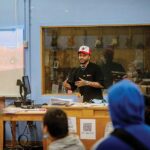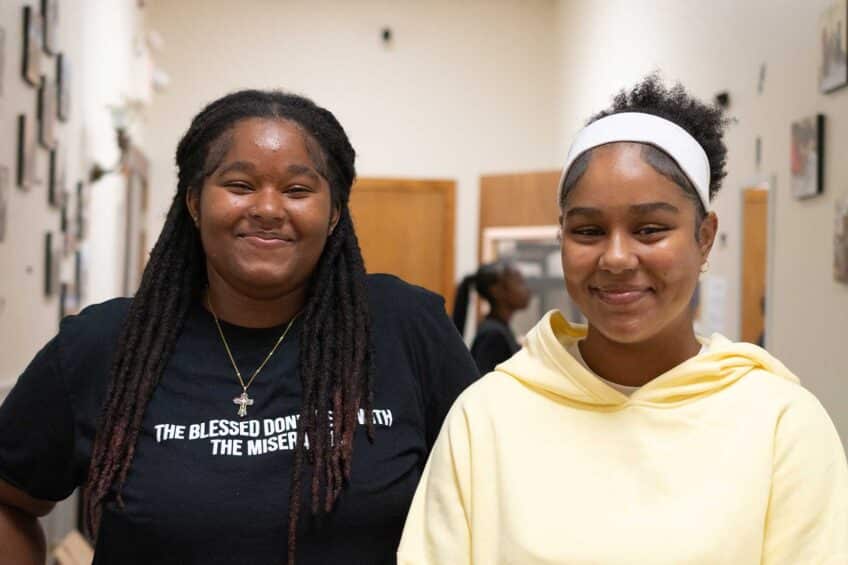



Dr. S. Allen Counter, president of the Harvard Foundation (second from right), poses for a photo with several Inuits during his recent trip to the North Pole to commemorate the legendary landmark’s April 6, 1909, discovery by U.S. Navy Commander Robert Peary and Matthew Henson. (Photo courtesy of Dr. S. Allen Counter)
|
|
|
Dr. S. Allen Counter (left) is here seen with descendants of U.S. Navy Commander Robert Peary, Matthew Henson and Polar Inuit leader Ootah, celebrating the 100th anniversary of the April 6, 1909, discovery of the North Pole. (Photo courtesy of Dr. S. Allen Counter) |
|
Before embarking on his trip to the North Pole to commemorate the centennial of the discovery of the North Pole, Dr. S. Allen Counter created a multi-compartment sealed Plexiglas case that contained, among other things, a triangular American flag, a Holy Bible from Harvard’s Memorial Church, copies of several books about the endeavor and a variety of Inuit cultural symbols. (Photo courtesy of Dr. S. Allen Counter) |
April 6, 2009, marked the 100th anniversary of the American discovery of the North Pole. On that day in 1909, Matthew Henson, an African American, and U.S. Navy Commander Robert Peary, a European American, along with four Polar Inuits (“Eskimos”) led by tribal leader Ootah, became the first humans to stand at the top of the Earth.
There is considerable scientific and other evidence today to confirm that they did indeed reach 90 degrees N, the precise North Pole. As a Navy commander, Robert Peary was on a military mission of geographic discovery. Matthew Henson, his arctic aide of 18 years, had also served the Navy as a messenger and as a field assistant, the highest positions that a “colored” man could hold in the Navy at that time.
Reaching the North Pole in the early 1900s was viewed by international leaders as tantamount to reaching the moon in our lifetime, and explorers from many nations were competing for the international honor of this prize.
Matthew Henson and Commander Peary reached the North Pole by dogsled during a time when our country was socially and culturally different than today. Unfortunately, Robert Peary alone was credited with this momentous discovery, and Matthew Henson — who, by some accounts, reached the North Pole first, and of whom the commander had said, “I cannot make it without him” — was ignored by the press and left out of the history books because of the racial attitudes in the U.S. toward African Americans at that time.
Also left out of the history books was the fact that Robert Peary and Matthew Henson both fathered sons with Polar Inuit women in 1906 in Northwest Greenland.
I explored Arctic-Northwest Greenland on a number of expeditions in the late 1980s, and discovered and befriended the Inuit offspring fathered by Commander Peary and Matthew Henson.
With the help of Polar Inuit families in Northwest Greenland and high-ranking military officials, I was able to bring the 80-year-old Inuit sons of Matthew Henson, whose name was Anaukaq, and Robert Peary, whose name was Kali, to the U.S. on military planes to meet with their American relatives for the first time — and to place wreaths at their respective fathers’ graves.
This project, called the Harvard North Pole Family Reunion, took place in 1987. Anaukaq Henson, Kali Peary and their Inuit children were welcomed to America by Harvard President Derek C. Bok, and by an official message from President Ronald Reagan.
One year later, in an effort to correct another historic wrong, I requested and received an official order from the White House to remove Matthew Henson’s remains from a common grave in New York’s Woodlawn Cemetery, and to re-inter his body in Arlington National Cemetery among other American heroes and adjacent to Rear Admiral Robert E. Peary’s grave, with a fitting new monument and full military honors.
This story captured the American imagination and was covered nationally in most major American newspapers. The entire episode is covered in my book, “North Pole Legacy: Black, White and Eskimo.”
At the time of their celebrated visit to the U.S., I promised both Anaukaq and Kali that I would travel with members of their Inuit families to the North Pole on April 6, 2009, to commemorate the North Pole discovery by their American fathers in 1909.
I attempted to keep my word in this instance, because I knew that it would mean a great deal to both Anaukaq and Kali, proud Eskimo hunters who never knew their fathers, and who have since died. I was in regular contact with Admiral Peary’s and Matthew Henson’s Inuit grandchildren in the villages of Moriussaq and Qaanaaq, Greenland, near Thule Air Force Base, and they were very excited about joining me in the historic journey.
Last fall, in a meeting at Harvard with officers of the United States Air Force from Thule Air Base, I arranged to fly to the North Pole on a U.S. Air Force C-130 with skis, to land for a brief period to conduct a memorial ceremony for Matthew Henson, Robert Peary and their Inuit associates.
Unfortunately, I learned in March that an aircraft landing was not possible because of the unstable ice conditions.
I immediately arranged to fly a small, chartered aircraft from a Canadian-based company that works with the National Science Foundation in the transport of Arctic scientists. Unfortunately, the small aircraft had a limited range and seating capacity because of the need to transport fuel containers in place of passenger seats. Thus, I was limited in the number of Inuit family members that I could take to the North Pole. After discussions with the Henson and Peary families in Greenland, we decided that it was better to bring all of the Polar Inuit family members together in the village of Qaanaaq, Northwest Greenland, the northern-most inhabited settlement on Earth, to commemorate the centennial of the North Pole discovery.
Being aware of the discoverers’ association with the United States Navy, I contacted Admiral Melvin G. Williams Jr., commander of the Second Fleet, and shared with him my desire to honor their attainment of the North Pole by transporting to the North Pole a commemorative case containing memorabilia associated with the 1909 expedition.
A short time thereafter, I was informed that my request had been honored, and that the North Pole Discovery Centennial Commemorative Memorabilia Case would be transported to the North Pole on board the USS Annapolis (SSN 760).
I created a multi-compartment sealed Plexiglas case that contained a triangular American flag at the top; a Holy Bible from Harvard’s Memorial Church, signed and dedicated to the North Pole centennial by the Rev. Professor Peter Gomes; Rear Admiral Peary’s book of 1910, entitled “The North Pole”; Matthew Henson’s book of 1910, entitled “A Negro Explorer at the North Pole”; a letter from President Ronald Reagan in recognition of Peary’s and Henson’s achievements and their sons’ visit to America in 1987; my book, “North Pole Legacy: Black, White and Eskimo”; Inuit cultural symbols, including bear claws from a necklace and Eskimo sealskin gloves worn by Henson’s son Anaukaq; an insignia cap from the launching of the USNS Henson; as well as photographs, letters and poems from family and others associated with or touched by the story of Commander Peary, Matthew Henson and their Greenlandic descendants.
In a letter dated April 6, 2009, Vice Admiral Williams wrote:
“I wish to convey my sincere congratulations to you and the entire team that made the Harvard North Pole Discovery Centennial Commemorative Project a success. We have confirmed through the U.S. Navy Commander, Submarine Force that the Henson-Peary memorabilia case successfully made it aboard USS ANNAPOLIS (SSN 760) and reached the North Pole.”
On April 6, 2009, in the village of Qaanaaq, Greenland, about 40 descendants of Matthew Henson, Robert Peary and Ootah gathered in the local schoolhouse for a celebration of the 100th anniversary of the North Pole discovery by their grandfathers. In addition to traditional Inuit food, including raw seal, walrus and polar bear, the Inuit descendants prepared a cake decorated with the phrase “Happy 100 År Anniversary.”
During the ceremony, I presented the families with a letter sent to me by President Barack Obama to mark the occasion, and a picture of the first family to be placed in the local schoolhouse. In his letter, President Obama wrote:
“I am pleased to join all who are commemorating the last hundred years of Arctic exploration … Many pioneers braved harsh conditions and beat the longest of odds to explore one of the final terrestrial frontiers — the North Pole … It is only fitting that we honor all those who have risked their lives and well-being to expand our knowledge of our continuously evolving planet. I commend those gathered for this occasion for continuing America’s proud tradition of exploration and scientific discovery.”
Dr. S. Allen Counter is the director of the Harvard Foundation and a professor of neurology and neurophysiology at Harvard Medical School.






